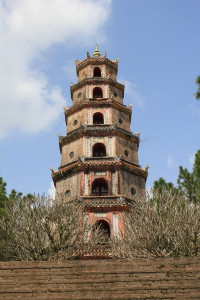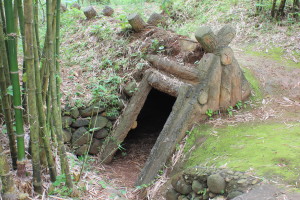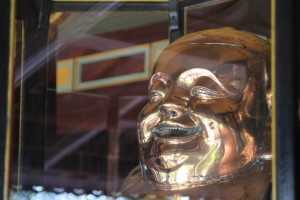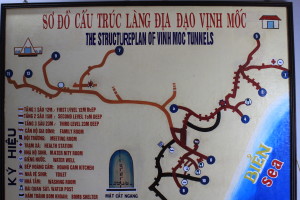 It was a 4 hour drive to the city of Hue from our last stop in the central highlands. Multi-hour drives in Asia are never easy on busted roads and always seem to involve a surprise 40 minute bathroom stop at the driver’s “cousin’s” pearl/jade/silk store. We opted to take a semi-private tour of the former Demilitarized Zone instead with the hope of making some of the stops more meaningful.
It was a 4 hour drive to the city of Hue from our last stop in the central highlands. Multi-hour drives in Asia are never easy on busted roads and always seem to involve a surprise 40 minute bathroom stop at the driver’s “cousin’s” pearl/jade/silk store. We opted to take a semi-private tour of the former Demilitarized Zone instead with the hope of making some of the stops more meaningful.
Our first stop was the  incredibly impressive Vinh Moc tunnel complex when we reached the coast. During the war the US suspected that this village was supplying Anti Aircraft weapons and ammunition to a small island, which they were, that was shooting down planes flying north from Da Nang to bomb Hanoi. The town was north of the DMZ so was out of the reach of Marine or Army patrols making it a target of Naval Warships and Aircraft. An unbelievable amount of firepower was unleashed, up to 3 hours a day, causing the villagers to begin moving their village underground. The initial complex was 30 feet under the ground and was mainly a bomb shelter during attacks. The advent of American bunker busting bombs which could penetrate 10 meters into the earth before exploding rendered this depth up safe and the villagers would dig, with their hands, picks, and shovels, another 60 feet down for a total of 90 feet. There was a school, kitchens, a hospital and delivery room with 17 births during the war, guard houses and homes for families. An entire family would live in dug outs along the corridors maybe 8×5 feet in size. While there were two wells for water there was one bathroom for several hundred villagers. All three levels of the tunnels stretched 1800 meters in length with exits in the village above, where a network of trenches connected houses, and at the beach below where they were resupplied by boats from the north. Not a single person was ever killed in the tunnel system during the war despite warships and planes dropping massive tonnage of ordinance, and they effectively disrupted US flights the entire time.
incredibly impressive Vinh Moc tunnel complex when we reached the coast. During the war the US suspected that this village was supplying Anti Aircraft weapons and ammunition to a small island, which they were, that was shooting down planes flying north from Da Nang to bomb Hanoi. The town was north of the DMZ so was out of the reach of Marine or Army patrols making it a target of Naval Warships and Aircraft. An unbelievable amount of firepower was unleashed, up to 3 hours a day, causing the villagers to begin moving their village underground. The initial complex was 30 feet under the ground and was mainly a bomb shelter during attacks. The advent of American bunker busting bombs which could penetrate 10 meters into the earth before exploding rendered this depth up safe and the villagers would dig, with their hands, picks, and shovels, another 60 feet down for a total of 90 feet. There was a school, kitchens, a hospital and delivery room with 17 births during the war, guard houses and homes for families. An entire family would live in dug outs along the corridors maybe 8×5 feet in size. While there were two wells for water there was one bathroom for several hundred villagers. All three levels of the tunnels stretched 1800 meters in length with exits in the village above, where a network of trenches connected houses, and at the beach below where they were resupplied by boats from the north. Not a single person was ever killed in the tunnel system during the war despite warships and planes dropping massive tonnage of ordinance, and they effectively disrupted US flights the entire time.
Spending 15 minutes bent over double moving in those dark tunnels and thinking about all dirt above us was enough for Vanessa and I. We were very happy to emerge at the beach and breath fresh air.
After the tunnels we visited the memorial at the crossing of the Ben Hai River which the was traditional border of the north and south. Attached is a picture of how extensive the bomb damage was to the north where the tunnels were. The meuseum had a collection of US relics from captured pilots and a large collection of American weapons and explanations of how they were used to kill Vietnamese. A sobering experience to say the least and not as overtly propaganda driven as the Chinese museum in Tibet that we visited last year. Just uncomfortable in your face images of Americans waging war that needed to be looked at even if it smarted a little bit.
We arrived to the beautiful city of Hue and the not-so-perfume-smelling Perfume River. The dominating center of town is the old capital complex called the Citadel which was fashioned after the forbidden city in Beijing. A sprawling complex of ruins in various states of repair with some very nice exhibits of old imperial life. During the 1968 Tet Offensive Hue was over run, almost every single US outpost in Vietnam was attacked overnight, and the Vietcong held the Citadel for 4 weeks against the full US military. Hue saw the worst fighting along with the fire base Khe Sanh, and nearly all of the Citadel was destroyed by plane and artillery bombardment. Evidence off machine gun and grenade damage was everywhere along the walls and buildings and the battle was well documented by US journalist whose pictures were displayed thoroughly the exhibits. Projects supported by Dutch, German and Japanese grants are restoring many of the buildings to their former states but probably 50% is completely leveled. It was a great on your own tour and about 3 billion times
Less crowded than Beijings version!
Following a classic Dempsey Deathmarch to a pagoda, “come on honey the map says its only 4k”, we called it a day. The pagoda was a operating temple which was also the sight of the famous Monks self-immolation during the war in protest to the regime of South Vietnamese president Diem. One of the most published pictures of the war, it was hard to imagine as we sat looking out over the river, surrounded by Buddhas and the sound of monks gently ringing bells.
Our second excursion was by bike out to the suburbs and the old imperial tombs of the kings. They are vast and gaudy tombs with amazing architecture and sculptures. Some became castles of sorts after the people grew rebelliousabout the amount of money, and forced labor, used to build them. They represented the height of the great Nyugen Dynasty which ruled for much of the past thousand years. About 90% of the people carry that last name in Vietnam as a result we are told. Needless to say, biking through a Vietnam city in rush hour was a wild experience, especially when the breaks on your bike necessitate putting your feet on the ground to be effective, and we felt very accomplished after living through it.
Hue was a great city to spend a few days. For some some reason many Vietnamese had told us to blow through or skip it but we had a wonderful time. There was a great old city and backpacker seen there and it was fun to drink some beers, eat some pizza and watch all the grubby, bearded, and fresh dressed in “yes I bought these yoga pants in Thailand” outfits.
Now for a few days at the beach and then on to the great wonder of the world Angkor Wat and Cambodia.


Speak Your Mind